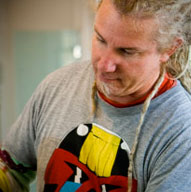
Hair Designer
When did you first realise that you had a different way of thinking?
I didn’t. I thought I was normal for the first three to four years at school. Then I realised something was going on. Words would jump around in circles for me. I was diagnosed late, at 35.
What was your experience of school?
School was fantastic because I just played sport, ate my lunch and talked to the girls. I learnt to get around it without them given me a hard time. I’d get other people to do my English homework for me while I used to do everyone’s math.
How did you get involved in hair designing?
My flatmate was a hairdresser. I was working for a sports company as a sales rep at the time. My flatmate had Thursday night drinks at his salon one night and invited me along. I just thought it was a fantastic profession and I decided to pursue it.
What are the main work challenges that you have had to overcome?
Exams. The written exams were reasonably difficult for me, but not the practicals. I learnt to have a very, very good memory, learnt to visualise the words to get on paper, and hoped the examiner would understand my spelling and grammar.
What do you think are some of the positives and negatives of dyslexia?
I think people are dyslexic are extremely lucky. It’s other people who are boring and dull – the world is too straight. As for the negatives, it’s that people who don’t have dyslexia don’t understand you, even though you understand them perfectly.
What advice would you give young New Zealanders who are dyslexic?
Make sure that you understand that you are perfectly normal – and that your self-esteem is extremely strong. Don’t allow society to screw your head in. The majority of people who are dyslexic are quick thinkers – but most people don’t understand this so they’ll try and put you down.
Click here to return.
